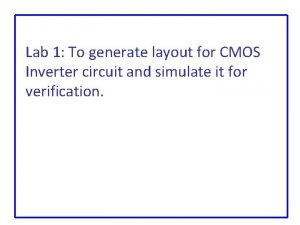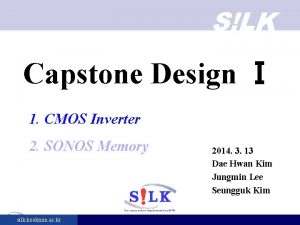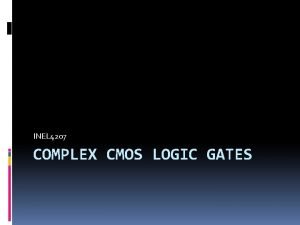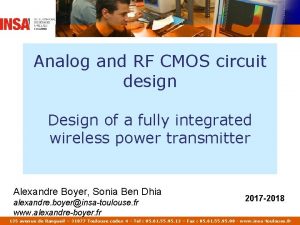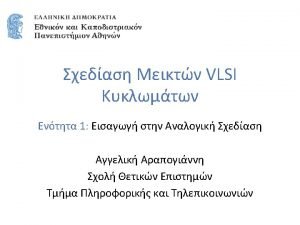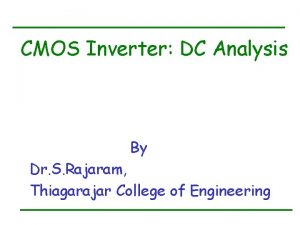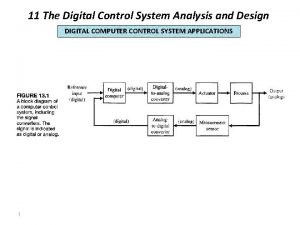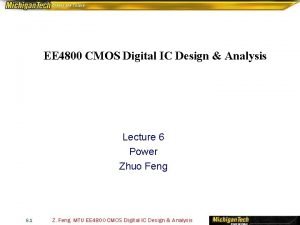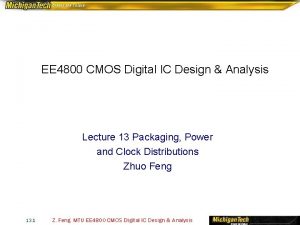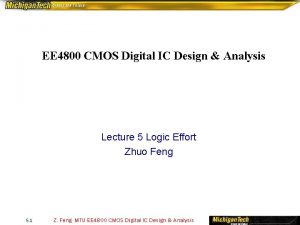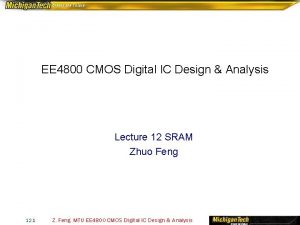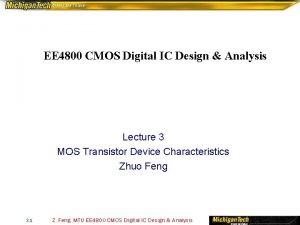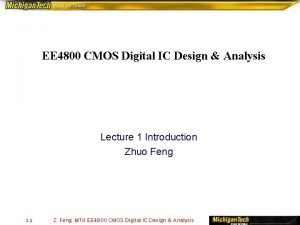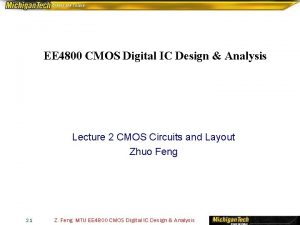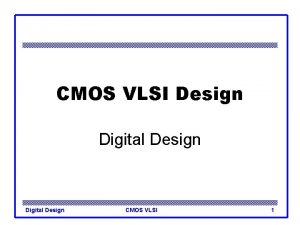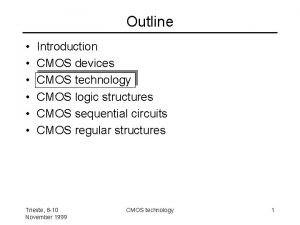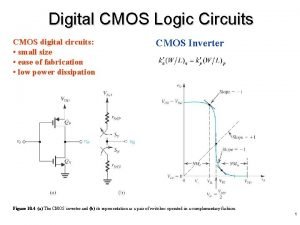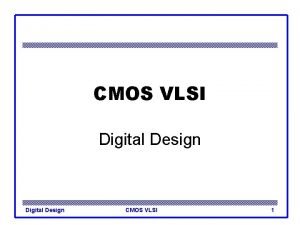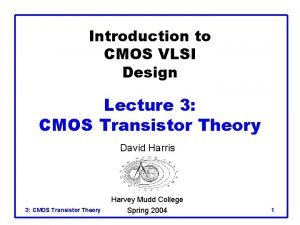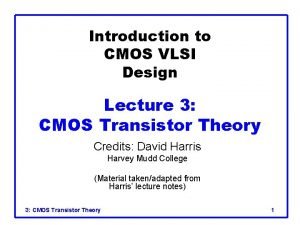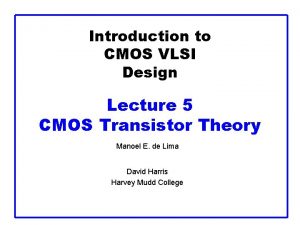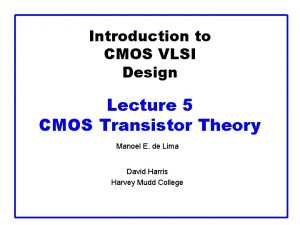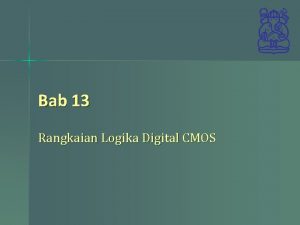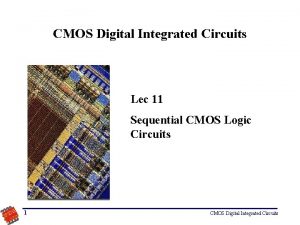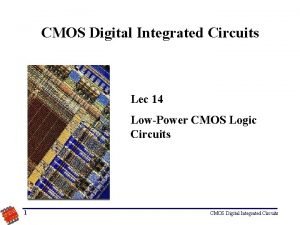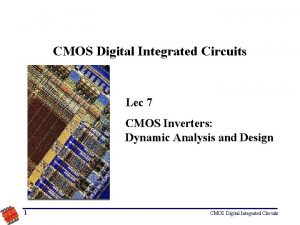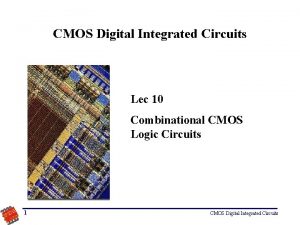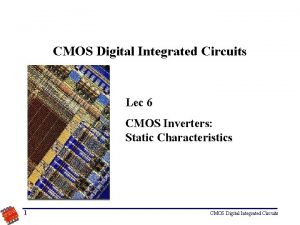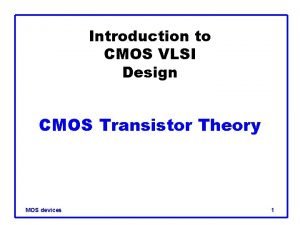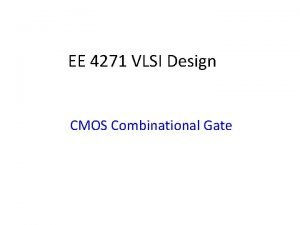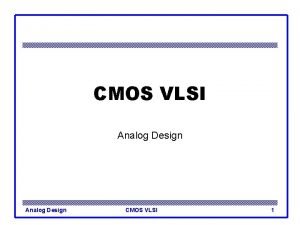EE 4800 CMOS Digital IC Design Analysis Lecture

























- Slides: 25

EE 4800 CMOS Digital IC Design & Analysis Lecture 11 Sequential Circuit Design Zhuo Feng 11. 1 Z. Feng MTU EE 4800 CMOS Digital IC Design & Analysis 2010

Outline ■ ■ Sequencing Element Design Max and Min-Delay Clock Skew 11. 2 Z. Feng MTU EE 4800 CMOS Digital IC Design & Analysis 2010

Sequencing ■ Combinational logic ► output depends on current inputs ■ Sequential logic ► output depends on current and previous inputs ► Requires separating previous, current, future ► Called state or tokens ► Ex: FSM, pipeline 11. 3 Z. Feng MTU EE 4800 CMOS Digital IC Design & Analysis 2010

Sequencing Cont. ■ If tokens moved through pipeline at constant speed, no sequencing elements would be necessary ■ Ex: fiber-optic cable ► Light pulses (tokens) are sent down cable ► Next pulse sent before first reaches end of cable ► No need for hardware to separate pulses ► But dispersion sets min time between pulses ■ This is called wave pipelining in circuits ■ In most circuits, dispersion is high ► Delay fast tokens so they don’t catch slow ones. 11. 4 Z. Feng MTU EE 4800 CMOS Digital IC Design & Analysis 2010

Sequencing Overhead ■ Use flip-flops to delay fast tokens so they move through exactly one stage each cycle. ■ Inevitably adds some delay to the slow tokens ■ Makes circuit slower than just the logic delay ► Called sequencing overhead ■ Some people call this clocking overhead ► But it applies to asynchronous circuits too ► Inevitable side effect of maintaining sequence 11. 5 Z. Feng MTU EE 4800 CMOS Digital IC Design & Analysis 2010

Sequencing Elements ■ Latch: Level sensitive ► a. k. a. transparent latch, D latch ■ Flip-flop: edge triggered ► A. k. a. master-slave flip-flop, D register ■ Timing Diagrams ► Transparent ► Opaque ► Edge-trigger 11. 6 Z. Feng MTU EE 4800 CMOS Digital IC Design & Analysis 2010

Sequencing Elements ■ Latch: Level sensitive ► a. k. a. transparent latch, D latch ■ Flip-flop: edge triggered ► A. k. a. master-slave flip-flop, D register ■ Timing Diagrams ► Transparent ► Opaque ► Edge-trigger 11. 7 Z. Feng MTU EE 4800 CMOS Digital IC Design & Analysis 2010

Latch Design ■ Pass Transistor Latch ■ Pros + Tiny + Low clock load ■ Cons ► Vt drop ► nonrestoring ► backdriving Used in 1970’s ► output noise sensitivity ► dynamic ► diffusion input 11. 8 Z. Feng MTU EE 4800 CMOS Digital IC Design & Analysis 2010

Latch Design ■ Transmission gate + No Vt drop - Requires inverted clock 11. 9 Z. Feng MTU EE 4800 CMOS Digital IC Design & Analysis 2010

Latch Design ■ Inverting buffer + Restoring + No backdriving + Fixes either ▼ Output noise sensitivity ▼ Or diffusion input ► Inverted output 11. 10 Z. Feng MTU EE 4800 CMOS Digital IC Design & Analysis 2010

Latch Design ■ Tristate feedback + Static ► Backdriving risk ■ Static latches are now essential 11. 11 Z. Feng MTU EE 4800 CMOS Digital IC Design & Analysis 2010

Latch Design ■ Buffered input + Fixes diffusion input + Noninverting 11. 12 Z. Feng MTU EE 4800 CMOS Digital IC Design & Analysis 2010

Latch Design ■ Buffered output + No backdriving ■ Widely used in standard cells + Very robust (most important) - Rather large - Rather slow (1. 5 – 2 FO 4 delays) - High clock loading 11. 13 Z. Feng MTU EE 4800 CMOS Digital IC Design & Analysis 2010

Latch Design ■ Datapath latch + Smaller, faster - unbuffered input 11. 14 Z. Feng MTU EE 4800 CMOS Digital IC Design & Analysis 2010

Flip-Flop Design ■ Flip-flop is built as pair of back-to-back latches 11. 15 Z. Feng MTU EE 4800 CMOS Digital IC Design & Analysis 2010

Enable ■ Enable: ignore clock when en = 0 ► Mux: increase latch D-Q delay ► Clock Gating: increase en setup time, skew 11. 16 Z. Feng MTU EE 4800 CMOS Digital IC Design & Analysis 2010

Reset ■ Force output low when reset asserted ■ Synchronous vs. asynchronous 11. 17 Z. Feng MTU EE 4800 CMOS Digital IC Design & Analysis 2010

Set / Reset ■ Set forces output high when enabled ■ Flip-flop with asynchronous set and reset 11. 18 Z. Feng MTU EE 4800 CMOS Digital IC Design & Analysis 2010

Sequencing Methods ■ Flip-flops ■ 2 -Phase Latches ■ Pulsed Latches 11. 19 Z. Feng MTU EE 4800 CMOS Digital IC Design & Analysis 2010

Timing Diagrams Contamination and Propagation Delays tpd Logic Prop. Delay tcd Logic Cont. Delay tpcq Latch/Flop Clk-Q Prop Delay tccq Latch/Flop Clk-Q Cont. Delay tpdq Latch D-Q Prop Delay tpcq Latch D-Q Cont. Delay tsetup Latch/Flop Setup Time thold Latch/Flop Hold Time 11. 20 Z. Feng MTU EE 4800 CMOS Digital IC Design & Analysis 2010

Max-Delay: Flip-Flops 11. 21 Z. Feng MTU EE 4800 CMOS Digital IC Design & Analysis 2010

Max Delay: Pulsed Latches 11. 22 Z. Feng MTU EE 4800 CMOS Digital IC Design & Analysis 2010

Min-Delay: Flip-Flops 11. 23 Z. Feng MTU EE 4800 CMOS Digital IC Design & Analysis 2010

Clock Skew ■ We have assumed zero clock skew ■ Two types of clock skews: ► Negative skew: sending register receives the clock earlier than the receiving register ► Positive skew: receiving register gets the clock earlier than the sending register. ■ Clocks really have uncertainty in arrival time ► Decreases maximum propagation delay ► Increases minimum contamination delay ► Decreases time borrowing 11. 24 Z. Feng MTU EE 4800 CMOS Digital IC Design & Analysis 2010

Skew: Flip-Flops 11. 25 Z. Feng MTU EE 4800 CMOS Digital IC Design & Analysis 2010
 Cmos vlsi design lecture notes
Cmos vlsi design lecture notes 4800 oak grove drive pasadena
4800 oak grove drive pasadena 4800 oak grove drive
4800 oak grove drive Early beginnings of tourism
Early beginnings of tourism Sistema vds
Sistema vds Checkpoint 12600
Checkpoint 12600 Mazak fh 4800
Mazak fh 4800 01:640:244 lecture notes - lecture 15: plat, idah, farad
01:640:244 lecture notes - lecture 15: plat, idah, farad Layout of cmos inverter in vlsi
Layout of cmos inverter in vlsi Cmos design rules
Cmos design rules Inverter cross section
Inverter cross section Or logic gate
Or logic gate Device modeling for analog and rf cmos circuit design
Device modeling for analog and rf cmos circuit design Analog and digital difference
Analog and digital difference Dc characteristics of cmos inverter
Dc characteristics of cmos inverter Digital control system application
Digital control system application Eurocode 2 lap length table
Eurocode 2 lap length table Elemen urban design
Elemen urban design Principles of design in interior design ppt
Principles of design in interior design ppt Lecture hall acoustic design
Lecture hall acoustic design Game design lecture
Game design lecture Computer aided drug design lecture notes
Computer aided drug design lecture notes Exploratory data analysis lecture notes
Exploratory data analysis lecture notes Sensitivity analysis lecture notes
Sensitivity analysis lecture notes Factor analysis lecture notes
Factor analysis lecture notes Analysis of algorithms lecture notes
Analysis of algorithms lecture notes








